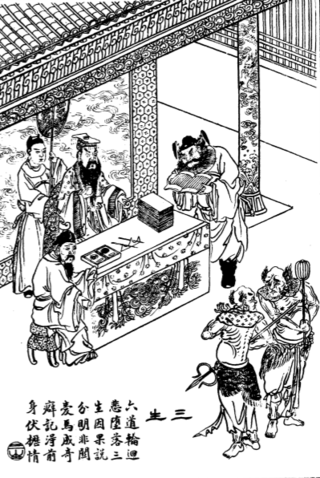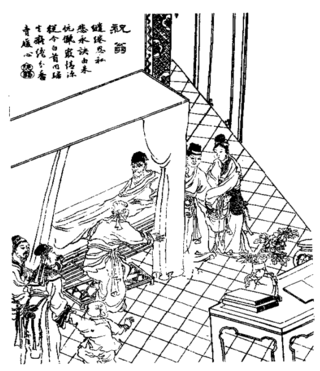
Pu Songling was a Chinese writer during the Qing dynasty, best known as the author of Strange Tales from a Chinese Studio.

"Cut Sleeve" is a short story by Pu Songling first published in the third volume of Strange Stories from a Chinese Studio. The story features He Shican, a homosexual studio owner who becomes smitten with Huang Jiulang, a fox spirit, and their subsequent lives as a reborn government official and the lover of another gay official, respectively. "Cut Sleeve" is notable for being a full-length narrative on homosexuality in China; the title alludes to Emperor Ai of Han's same-sex relationship with Dong Xian.

"A Sequel to the Yellow Millet Dream", also translated as "Dr Tsêng's Dream", is a short story written by Chinese author Pu Songling in Strange Tales from a Chinese Studio (1740). The story revolves around an ambitious scholar whose dreams of becoming prime minister apparently come true, and his subsequent fall from grace. Inspired by previous works of the same genre, "A Sequel to the Yellow Millet Dream" was received favourably by literary critics.

"This Transformation", also known as "The Begging Monk", is a short story by Pu Songling collected in Strange Stories from a Chinese Studio (1740). The tale revolves around a monk who begs for nothing in particular and is treated like an outcast. It was first fully translated into English by John Minford in 2006, followed by Sidney L. Sondergard in 2008.

Dragon Dormant, also known as The Hibernating Dragon, is a short story by Chinese author Pu Songling collected in Strange Tales from a Chinese Studio. The story is about a character named "Commissioner Qu" and his encounter with a supernatural creature in his study.

"Zhang Hongjian" is a short story by the Chinese writer Pu Songling collected in Strange Tales from a Chinese Studio in 1740, and translated by Sidney L. Sondergard in 2012. Set in various parts of 18th-century China, the story revolves around the title character and his misadventures while on the run. Pu adapted the story into two of his plays.

"A Strange Matter Concerning Pigeons", also translated variously as "A Strange Tale of Pigeons" or "A Strangeness of Pigeons", is a short story by Pu Songling first published in Strange Stories from a Chinese Studio (1740). It revolves around Zhang Youliang, an avid pigeon-keeper who befriends a fellow collector and is entrusted to care for a few of his pigeons. The story has been translated into both English and French, and adapted into an art installation.

"Stealing Peaches", also variously translated as "The Peach Theft", "Theft of the Peach", "Stolen Peaches", and "Stealing a Peach", is a short story by Pu Songling, first published in Strange Stories from a Chinese Studio (1740). It is told in first person by Pu himself, and revolves around a magic trick similar to the Indian rope trick; Pu claims to have witnessed it personally as a child.

"The Foreign Monks" is a short story by Pu Songling first published in Strange Tales from a Chinese Studio in 1740. It concerns two foreign monks and their amazing feats.

"A Brilliant Light" is a short story by the Chinese writer Pu Songling collected in Strange Tales from a Chinese Studio.

"Three Lives" is a short story by Pu Songling first published in Strange Tales from a Chinese Studio which follows the past lives of a scholar. It has been adapted into a play and translated into English.

Three Incarnations, also translated as Three Lives, is a short story by Pu Songling first published in Strange Tales from a Chinese Studio which revolves around two men who, during the course of three lifetimes, are in constant conflict with one another.

"The Bird Language" is a short story by Pu Songling, first published in Strange Tales from a Chinese Studio (1740). It is a brief anecdote about a Taoist monk who can communicate with birds, which has been suggested to be a criticism of the corrupt bureaucracy in Pu's time.

"Growing Pears", also variously translated as "Planting a Pear Tree", "Sowing Pears", and "The Wonderful Pear Tree", is a short story by Pu Songling, first published in Strange Tales from a Chinese Studio. Set in ancient China, the story revolves around a miserly pear seller and a Taoist priest.

"The Wutong Spirits" is a short story by Pu Songling first published in Strange Tales from a Chinese Studio. It follows locals in Southern China who are terrorised by one of the Wutong Shen, a group of five malevolent spirits. The antagonist reappears in the following Strange Tales story titled "Another Wutong Spirit".

"Hu Dagu" is a short story by Pu Songling first published in Strange Tales from a Chinese Studio. The story follows a Shandong family that is terrorised by the title character—a malevolent fox spirit—who wishes to betroth the patriarch's son. Pu modelled the antagonist after a female latrine spirit worshipped in ancient Chinese folk religion.

"Cai Weiweng" is a short story by Pu Songling first published in Strange Tales from a Chinese Studio. Set at the end of the Ming dynasty, the story follows the enigmatic title character who assists an army commander in training his troops.

"The Shuimang Herb", also translated as "The Shuimang Plant", is a short story by Pu Songling first published in Strange Tales from a Chinese Studio.

"Old Man Zhu" is a short story by Pu Songling, first published in Strange Tales from a Chinese Studio (1740). It revolves around the titular gentleman who returns from the dead to fetch his wife.

"Fourth Sister Hu" is a short story by Pu Songling, first published in Strange Tales from a Chinese Studio (1740). It revolves around a Chinese scholar who encounters a pair of fox spirits.




















